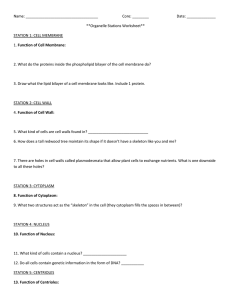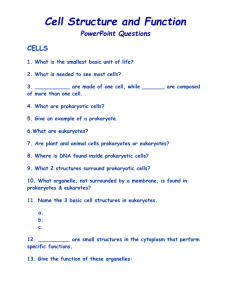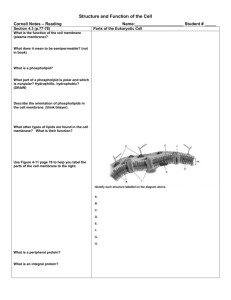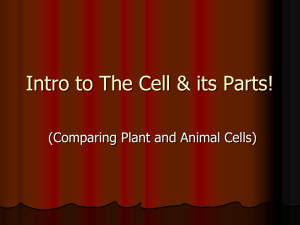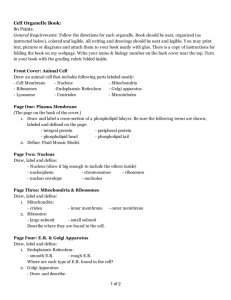Unit 2 Reloop
advertisement
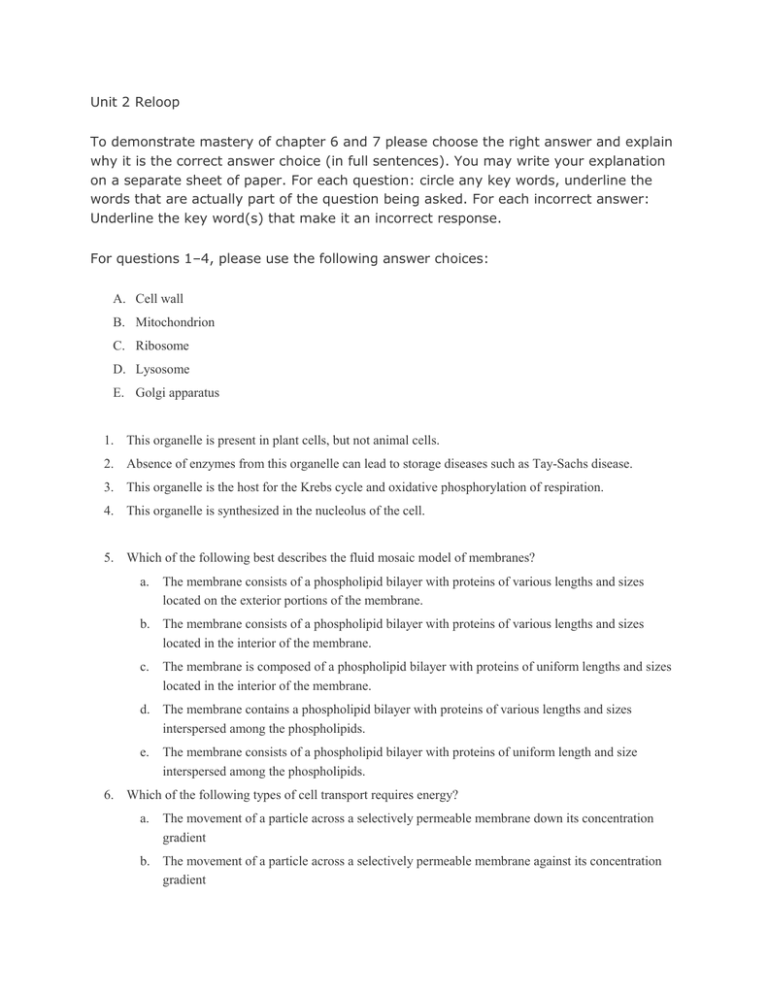
Unit 2 Reloop To demonstrate mastery of chapter 6 and 7 please choose the right answer and explain why it is the correct answer choice (in full sentences). You may write your explanation on a separate sheet of paper. For each question: circle any key words, underline the words that are actually part of the question being asked. For each incorrect answer: Underline the key word(s) that make it an incorrect response. For questions 1–4, please use the following answer choices: A. Cell wall B. Mitochondrion C. Ribosome D. Lysosome E. Golgi apparatus 1. This organelle is present in plant cells, but not animal cells. 2. Absence of enzymes from this organelle can lead to storage diseases such as Tay-Sachs disease. 3. This organelle is the host for the Krebs cycle and oxidative phosphorylation of respiration. 4. This organelle is synthesized in the nucleolus of the cell. 5. Which of the following best describes the fluid mosaic model of membranes? a. The membrane consists of a phospholipid bilayer with proteins of various lengths and sizes located on the exterior portions of the membrane. b. The membrane consists of a phospholipid bilayer with proteins of various lengths and sizes located in the interior of the membrane. c. The membrane is composed of a phospholipid bilayer with proteins of uniform lengths and sizes located in the interior of the membrane. d. The membrane contains a phospholipid bilayer with proteins of various lengths and sizes interspersed among the phospholipids. e. The membrane consists of a phospholipid bilayer with proteins of uniform length and size interspersed among the phospholipids. 6. Which of the following types of cell transport requires energy? a. The movement of a particle across a selectively permeable membrane down its concentration gradient b. The movement of a particle across a selectively permeable membrane against its concentration gradient c. The movement of water down its concentration gradient across selectively permeable membranes d. The movement of a sodium ion from an area of higher concentration to an area of lower concentration e. The movement of a particle across a selectively permeable membrane with the assistance of the membrane's transport proteins 7. Which of the following structures is present in prokaryotic cells? a. Nucleus b. Mitochondria c. Cell wall d. Golgi apparatus e. Lysosome 8. Which of the following represents an incorrect description of an organelle's function? a. Chloroplast: the site of photosynthesis and energy production in plant cells b. Peroxisome: organelle that produces hydrogen peroxide as a by-product of reactions involved in the breakdown of fatty acids, and detoxification of alcohol in the liver c. Golgi apparatus: structure to which proteins, lipids, and other macromolecules are sent to be modified by the addition of sugars and other molecules to form glycoproteins d. Rough endoplasmic reticulum: membrane bound organelle lacking ribosomes on its cytoplasmic surface, involved in lipid synthesis, detoxification, and carbohydrate metabolism. e. Nucleus: the control center in eukaryotic cells, which acts as the site for replication, transcription, and posttranscriptional modification of RNA 9. The destruction of which of the following would most cripple a cell's ability to undergo cell division? a. Microfilaments b. Intermediate filaments c. Microtubules d. Actin fibers e. Keratin fibers 10. Which of the following can easily diffuse across a selectively permeable membrane? a. Na+ b. Glucose c. Large uncharged polar molecules d. Charged ions e. Lipids 11. Which cellular structure is common to all 3 domains of life? a) Nucleus b) Endoplasmic reticulum c) Mitochondria d) Phospholipid bilayer cell membrane e) Endocytotic vesicles Difference between Plant and Animal Cells 12. Which of these organelles are absent in plant cells? a) mitochondria b) centrioles c) microtubules d) all of the above e) none of the above Nucleic Acid Localization 13. If you treat cells with radioactive UTP, where in the cell would you expect the greatest concentration of radioactivity within the first few minutes? a) nuclear matrix b) cytoplasm c) rough ER d) nucleolus 14. Enzymes responsible for biosynthesis of membrane lipids would be located in what part of the cell? a) endoplasmic reticulum. b) nucleus. c) lysosomes. d) Golgi. e) plasma membrane Endomembrane System 15. A membrane protein synthesized in the rough ER may be directed to a) peroxisomes. b) lysosomes. c) mitochondria. d) all of the above Golgi 16. Brefeldin A is a drug that disrupts transport from the ER to the Golgi apparatus. What other organelles and membranes are affected? a) lysosomes, vacuoles, plasma membrane b) lysosomes, peroxisomes, plasma membrane c) vacuoles, mitochondria, plasma membrane d) lysosomes, vacuoles, nuclear membrane e) all intracellular organelles and membranes 17. According to the endosymbiont theory, which of the following organelles were once endosymbiotic prokaryotic organisms? a) Mitochondria and lysosomes b) Mitochondria and chloroplasts c) Chloroplasts and Golgi apparatus d) Golgi apparatus and ribosomes e) Ribosomes and lysosomes 18. Which of the following is not an argument for the theory that mitochondria and chloroplasts evolved from prokaryotic endosymbionts? a) Mitochondria and chloroplasts have double membranes. b) Mitochondria and chloroplasts have their own ribosomes. c) Mitochondria and chloroplasts have their own DNA. d) The mitochondrial and chloroplast genomes are circular. e) All of the above support the endosymbiotic theory. Microtubule Function 19. Taxol, a drug approved for treatment of breast cancer, prevents depolymerization of microtubules. What cellular function that affects cancer cells more than normal cells might taxol interfere with? a) maintaining cell shape b) cilia or flagella c) chromosome movements in cell division d) cell division (cleavage furrow formation) e) cytoplasmic streaming ECM in Plant and Animal Cells 20. The difference in the structures of animal cell extracellular matrix and plant cell walls reflects what fundamental difference(s) in their adaptive strategies? a) Animal cells must move more than plant cells. b) Animal cells have to be more responsive to changes in their environment. c) Animal cells have to communicate with each other more than plant cells. d) all of the above

